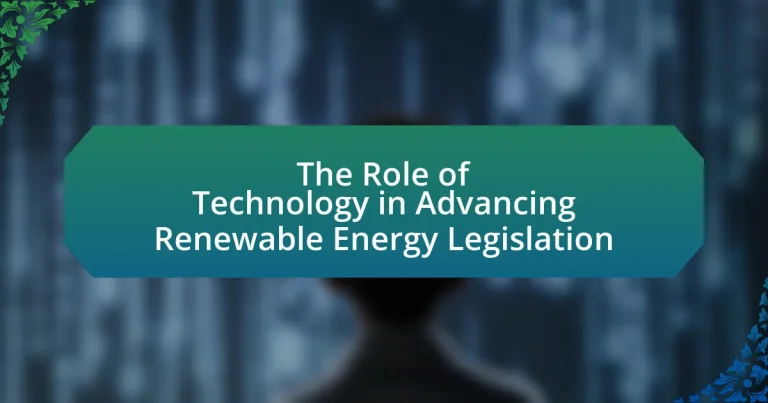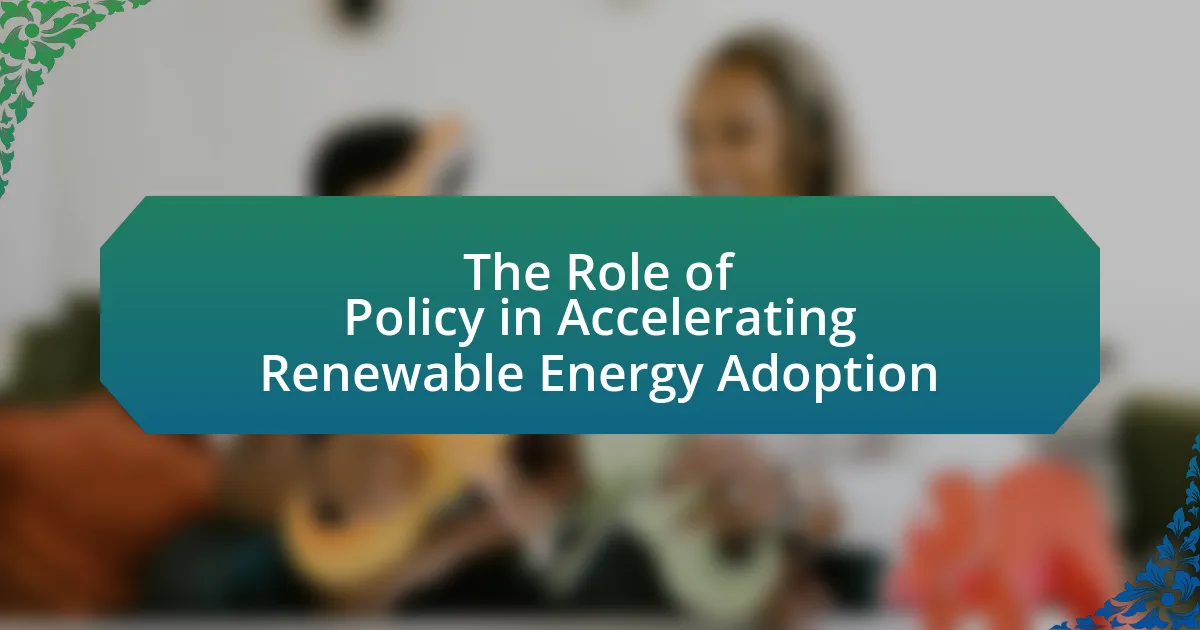The article focuses on the critical role of technology in advancing renewable energy legislation. It highlights how innovations such as energy storage systems, smart grid technologies, and data analytics inform policy decisions, enhance compliance, and facilitate stakeholder engagement. The discussion includes the impact of specific technologies like solar and wind energy on legislative frameworks, the challenges faced in integrating new technologies, and the importance of public-private partnerships in driving legislative advancements. Additionally, it outlines best practices for effectively incorporating technology into renewable energy laws to promote sustainability and efficiency.
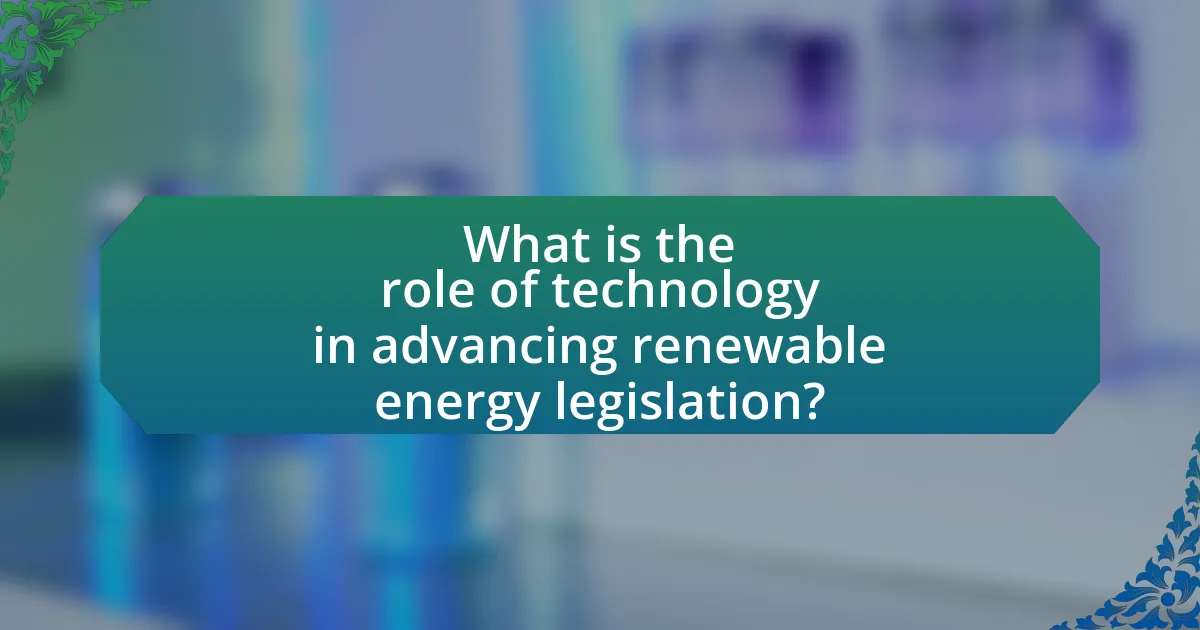
What is the role of technology in advancing renewable energy legislation?
Technology plays a crucial role in advancing renewable energy legislation by providing data-driven insights and innovative solutions that inform policy decisions. For instance, advancements in energy storage technologies, such as lithium-ion batteries, enhance the reliability of renewable energy sources, making them more attractive for legislative support. Additionally, smart grid technologies facilitate the integration of renewable energy into existing power systems, demonstrating the feasibility and benefits of transitioning to cleaner energy sources. According to the International Renewable Energy Agency, the global renewable energy capacity reached 2,799 gigawatts in 2020, largely due to technological innovations that have made renewable energy more efficient and cost-effective. These developments not only support the creation of favorable legislation but also encourage investment in renewable energy infrastructure, thereby accelerating the transition to sustainable energy systems.
How does technology influence the development of renewable energy policies?
Technology significantly influences the development of renewable energy policies by enabling advancements in energy efficiency, cost reduction, and integration of renewable sources into existing energy systems. For instance, innovations in solar panel technology have led to a decrease in costs by over 80% since 2010, making solar energy more accessible and prompting governments to adopt supportive policies. Additionally, smart grid technologies facilitate the integration of renewable energy sources, allowing for better management of energy supply and demand, which encourages policymakers to create frameworks that support renewable energy deployment. These technological advancements provide the necessary data and tools for policymakers to design effective regulations and incentives, ultimately driving the transition to a more sustainable energy future.
What technological advancements are shaping renewable energy legislation?
Technological advancements such as energy storage systems, smart grid technology, and renewable energy forecasting are significantly shaping renewable energy legislation. Energy storage systems, like lithium-ion batteries, enable the integration of intermittent renewable sources by storing excess energy for later use, thus influencing policies that promote grid reliability and renewable energy adoption. Smart grid technology enhances the efficiency of electricity distribution and consumption, prompting legislation that supports infrastructure upgrades and decentralized energy generation. Additionally, advancements in renewable energy forecasting improve the predictability of energy production from sources like wind and solar, leading to more informed regulatory frameworks that facilitate investment and grid management. These technologies collectively drive legislative changes aimed at increasing renewable energy capacity and ensuring a sustainable energy future.
How do these advancements impact legislative processes?
Advancements in technology significantly streamline legislative processes by enhancing data accessibility and improving communication among stakeholders. For instance, the use of digital platforms allows lawmakers to analyze vast amounts of data related to renewable energy more efficiently, leading to informed decision-making. Additionally, technology facilitates real-time collaboration and feedback from constituents, ensuring that legislative proposals reflect public interest and scientific evidence. This is evidenced by the increased use of online public comment systems and data visualization tools in legislative sessions, which have been shown to improve transparency and engagement in the legislative process.
Why is technology essential for effective renewable energy legislation?
Technology is essential for effective renewable energy legislation because it enables the development, implementation, and monitoring of sustainable energy solutions. Advanced technologies, such as smart grids and energy storage systems, facilitate the integration of renewable sources like solar and wind into existing energy infrastructures. For instance, the International Renewable Energy Agency reported that smart grid technologies can enhance energy efficiency by up to 30%, thereby supporting legislative goals for reduced carbon emissions. Furthermore, technology aids in data collection and analysis, allowing policymakers to make informed decisions based on real-time energy usage and environmental impact assessments. This data-driven approach ensures that legislation is responsive to current challenges and opportunities in the renewable energy sector.
What are the key benefits of integrating technology into renewable energy laws?
Integrating technology into renewable energy laws enhances efficiency, transparency, and compliance. Technology facilitates real-time monitoring of energy production and consumption, ensuring adherence to regulations and optimizing resource allocation. For instance, smart grid technologies enable better integration of renewable sources, reducing energy waste and improving reliability. Additionally, data analytics can identify trends and inform policy adjustments, leading to more effective legislation. The use of blockchain for tracking renewable energy credits ensures transparency and reduces fraud, further strengthening the legal framework. These technological advancements collectively contribute to a more robust and adaptive renewable energy sector.
How does technology enhance compliance and monitoring of renewable energy regulations?
Technology enhances compliance and monitoring of renewable energy regulations by providing real-time data analytics, automated reporting, and advanced tracking systems. These tools enable regulatory bodies and energy producers to monitor emissions, energy production, and compliance with standards more efficiently. For instance, the integration of Internet of Things (IoT) devices allows for continuous monitoring of renewable energy systems, ensuring they operate within regulatory limits. Additionally, blockchain technology can enhance transparency and traceability in renewable energy transactions, facilitating easier audits and compliance checks. According to a report by the International Renewable Energy Agency (IRENA), the use of digital technologies in energy management can reduce compliance costs by up to 30%, demonstrating the significant impact of technology on regulatory adherence.
What challenges does technology face in influencing renewable energy legislation?
Technology faces several challenges in influencing renewable energy legislation, primarily due to regulatory inertia, economic barriers, and public perception. Regulatory inertia occurs when existing laws and policies are slow to adapt to new technological advancements, hindering the integration of innovative solutions. Economic barriers include the high initial costs of implementing new technologies and the competition from established fossil fuel industries, which can deter investment in renewable energy initiatives. Additionally, public perception can be a significant challenge; misinformation about renewable technologies can lead to resistance among stakeholders and policymakers, impacting legislative support. These challenges collectively impede the effective influence of technology on the development and implementation of renewable energy legislation.
What are the barriers to adopting new technologies in legislative frameworks?
Barriers to adopting new technologies in legislative frameworks include regulatory inertia, lack of technical expertise, and insufficient funding. Regulatory inertia occurs when existing laws and regulations are slow to adapt to technological advancements, hindering innovation. A study by the National Renewable Energy Laboratory highlights that many legislators lack the technical knowledge necessary to understand and implement new technologies effectively. Additionally, insufficient funding limits the ability of legislative bodies to invest in research and development, which is crucial for integrating new technologies into existing frameworks. These factors collectively impede the progress of renewable energy legislation and the adoption of innovative solutions.
How can these challenges be overcome to facilitate better legislation?
To overcome challenges in advancing renewable energy legislation, stakeholders must leverage technology for data-driven decision-making and stakeholder engagement. Utilizing advanced analytics and modeling tools can provide lawmakers with precise insights into the potential impacts of proposed legislation, enabling more informed choices. For instance, the integration of Geographic Information Systems (GIS) can help visualize renewable energy resources and infrastructure needs, facilitating targeted policy development. Additionally, employing digital platforms for public consultation can enhance transparency and inclusivity, ensuring diverse perspectives are considered in the legislative process. Evidence from the International Renewable Energy Agency indicates that countries employing technology in their legislative frameworks have seen a 20% increase in the efficiency of policy implementation, demonstrating the effectiveness of these approaches.
How does technology facilitate stakeholder engagement in renewable energy legislation?
Technology facilitates stakeholder engagement in renewable energy legislation by providing platforms for communication, data sharing, and collaborative decision-making. Digital tools such as online forums, social media, and dedicated software enable stakeholders, including government agencies, industry representatives, and the public, to exchange information and express their views efficiently. For instance, the use of Geographic Information Systems (GIS) allows stakeholders to visualize the impact of proposed projects, fostering informed discussions. Additionally, technologies like blockchain enhance transparency in the legislative process, ensuring that all parties can track developments and contribute meaningfully. These advancements lead to more inclusive and participatory legislative processes, ultimately resulting in more effective and widely accepted renewable energy policies.
What role does data analytics play in shaping renewable energy policies?
Data analytics plays a crucial role in shaping renewable energy policies by providing insights that inform decision-making and optimize resource allocation. Through the analysis of large datasets, policymakers can identify trends in energy consumption, assess the effectiveness of existing policies, and forecast future energy needs. For instance, data analytics can reveal the potential for renewable energy sources in specific regions, guiding investments and incentives. A study by the International Renewable Energy Agency (IRENA) highlights that countries utilizing data analytics have seen a 20% increase in the efficiency of renewable energy projects, demonstrating the tangible impact of data-driven approaches on policy formulation.
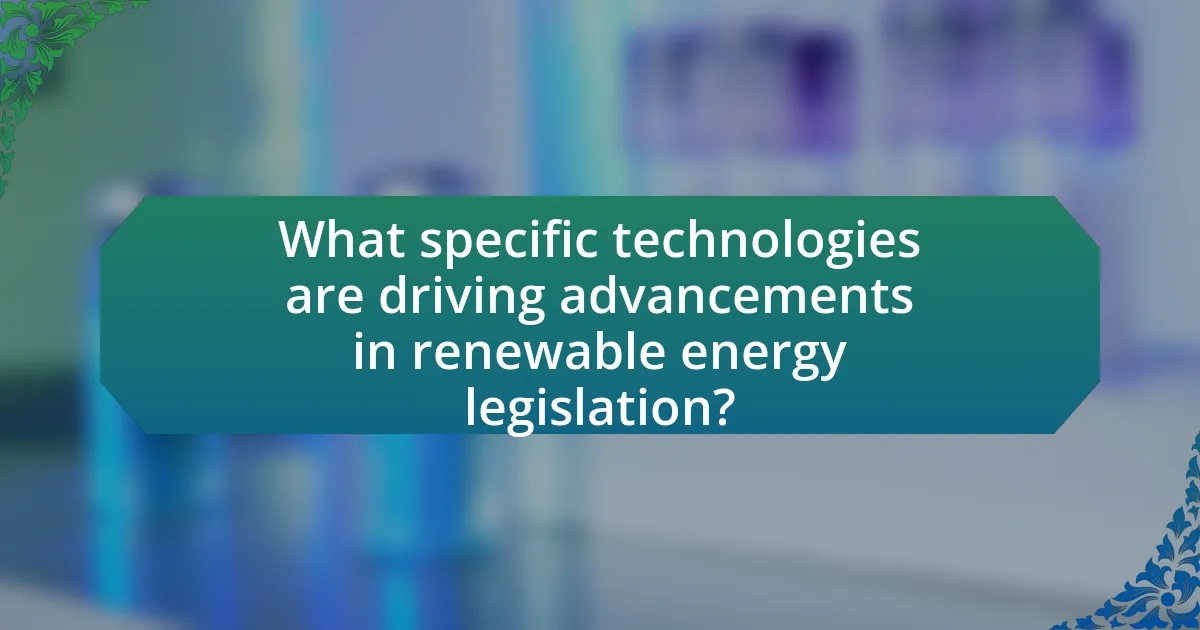
What specific technologies are driving advancements in renewable energy legislation?
Specific technologies driving advancements in renewable energy legislation include solar photovoltaic systems, wind turbine technology, and energy storage solutions. Solar photovoltaic systems have significantly reduced costs and increased efficiency, leading to supportive policies and incentives for solar energy adoption. Wind turbine technology has advanced with larger, more efficient turbines, prompting legislation that promotes wind energy development. Energy storage solutions, particularly lithium-ion batteries, enable better integration of renewable sources into the grid, influencing regulations that support energy resilience and reliability. These technologies collectively shape legislative frameworks aimed at enhancing renewable energy deployment and sustainability.
How do smart grids contribute to renewable energy policy development?
Smart grids enhance renewable energy policy development by enabling efficient integration and management of renewable energy sources. They facilitate real-time data exchange and communication between energy producers and consumers, which supports the optimization of energy distribution and consumption. For instance, smart grids can manage variable energy outputs from sources like solar and wind, ensuring stability in the energy supply. According to the U.S. Department of Energy, smart grid technologies can increase the share of renewables in the energy mix by up to 30% by improving grid reliability and flexibility. This capability informs policymakers by providing data-driven insights that shape effective renewable energy policies and regulations.
What are the benefits of smart grids for energy legislation?
Smart grids enhance energy legislation by improving efficiency, reliability, and integration of renewable energy sources. They enable real-time monitoring and management of energy consumption, which leads to reduced energy waste and lower operational costs. Additionally, smart grids facilitate the incorporation of distributed energy resources, such as solar and wind, into the energy mix, supporting legislative goals for increased renewable energy adoption. According to the U.S. Department of Energy, smart grid technologies can reduce electricity costs by up to 20% and significantly lower greenhouse gas emissions, aligning with legislative targets for sustainability and climate change mitigation.
How do smart grids improve energy distribution and regulation compliance?
Smart grids enhance energy distribution and regulation compliance by utilizing advanced communication and automation technologies to optimize the flow of electricity. These systems enable real-time monitoring and management of energy resources, which improves efficiency and reduces losses during transmission. For instance, smart grids facilitate demand response programs that adjust energy consumption based on supply conditions, thereby aligning with regulatory requirements for energy efficiency and sustainability. Additionally, they support the integration of renewable energy sources, such as solar and wind, into the grid, ensuring compliance with renewable portfolio standards. According to the U.S. Department of Energy, smart grid technologies can reduce peak demand by up to 15%, demonstrating their effectiveness in improving energy distribution and meeting regulatory standards.
What impact do renewable energy technologies have on legislative frameworks?
Renewable energy technologies significantly influence legislative frameworks by driving the development of policies that promote sustainable energy practices. These technologies necessitate new regulations to address issues such as grid integration, energy efficiency standards, and emissions reductions. For instance, the adoption of solar and wind energy has led to the implementation of feed-in tariffs and renewable portfolio standards in various jurisdictions, which mandate a certain percentage of energy to come from renewable sources. Additionally, the International Renewable Energy Agency reported that countries with advanced renewable technologies often see legislative reforms that facilitate investment and innovation in the energy sector, thereby enhancing energy security and reducing reliance on fossil fuels.
How do solar and wind technologies influence policy changes?
Solar and wind technologies influence policy changes by demonstrating the feasibility and benefits of renewable energy, which prompts governments to adopt supportive legislation. The rapid decline in costs for solar and wind energy—solar photovoltaic costs fell by 89% from 2009 to 2020, and onshore wind costs dropped by 70% in the same period—has made these technologies economically attractive, leading policymakers to create incentives such as tax credits and renewable portfolio standards. Additionally, the increasing public demand for clean energy solutions, driven by climate change awareness, has pressured legislators to implement policies that promote the adoption of solar and wind technologies, thereby shaping a regulatory environment that favors renewable energy development.
What role do energy storage solutions play in legislative advancements?
Energy storage solutions significantly influence legislative advancements by enabling the integration of renewable energy sources into the grid. These technologies, such as batteries and pumped hydro storage, provide essential services like load balancing and frequency regulation, which are critical for maintaining grid stability as renewable energy generation increases. For instance, the U.S. Energy Storage Association reported that energy storage capacity in the U.S. grew by 240% from 2017 to 2020, prompting lawmakers to create policies that support storage deployment, such as tax incentives and funding for research and development. This legislative support is crucial for accelerating the transition to a low-carbon energy system, as it addresses challenges related to intermittency and reliability of renewable energy sources.
How is artificial intelligence transforming renewable energy legislation?
Artificial intelligence is transforming renewable energy legislation by enabling data-driven decision-making and optimizing regulatory frameworks. AI technologies analyze vast amounts of energy consumption data, predict renewable energy generation, and assess environmental impacts, which helps lawmakers create more effective policies. For instance, AI algorithms can model the effects of different legislative scenarios on energy markets, allowing for more informed and adaptive regulations. Additionally, AI enhances compliance monitoring by automating the tracking of renewable energy targets and emissions, ensuring that legislation is enforced effectively. This integration of AI into legislative processes is supported by studies showing that data analytics can improve policy outcomes and stakeholder engagement in the energy sector.
What applications of AI are most relevant to energy policy?
AI applications most relevant to energy policy include predictive analytics for energy demand forecasting, optimization of energy distribution networks, and the integration of renewable energy sources into existing grids. Predictive analytics enables policymakers to anticipate energy consumption patterns, which can inform infrastructure investments and regulatory frameworks. Optimization algorithms enhance the efficiency of energy distribution, reducing waste and costs, while AI-driven models facilitate the seamless integration of renewable sources, such as solar and wind, into the energy mix. These applications are supported by studies showing that AI can improve grid reliability and reduce operational costs by up to 20%, thereby reinforcing the importance of AI in shaping effective energy policies.
How does AI improve decision-making in renewable energy legislation?
AI enhances decision-making in renewable energy legislation by providing data-driven insights that inform policy development and implementation. Through advanced analytics, AI can process vast amounts of data related to energy consumption, environmental impact, and economic factors, enabling legislators to make informed choices that align with sustainability goals. For instance, AI models can predict the outcomes of various legislative scenarios, allowing policymakers to evaluate the potential effectiveness of different regulations before they are enacted. This capability is supported by studies such as the one conducted by the International Renewable Energy Agency, which highlights how AI applications can optimize energy systems and improve regulatory frameworks, ultimately leading to more effective and efficient renewable energy policies.
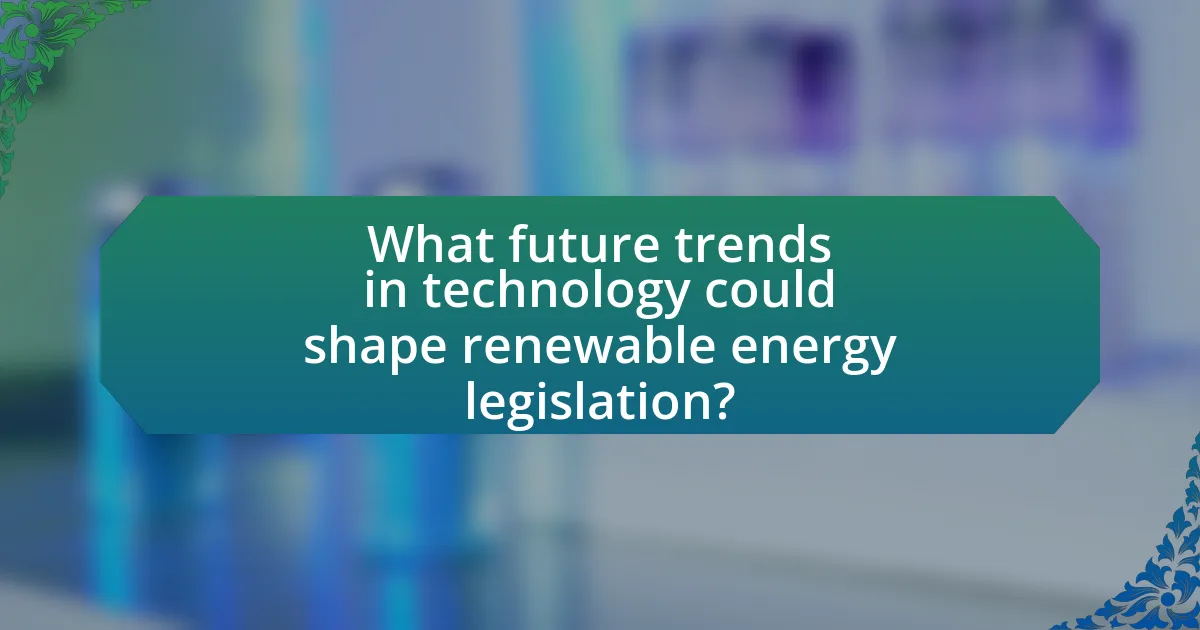
What future trends in technology could shape renewable energy legislation?
Future trends in technology that could shape renewable energy legislation include advancements in energy storage, smart grid technology, and artificial intelligence. Energy storage technologies, such as lithium-ion batteries and emerging solid-state batteries, enhance the reliability and efficiency of renewable energy sources by enabling energy to be stored and used when demand is high. Smart grid technology facilitates real-time monitoring and management of energy distribution, allowing for better integration of renewable sources into the existing grid. Artificial intelligence optimizes energy consumption and generation patterns, leading to more efficient use of resources. These technological advancements are likely to influence legislative frameworks by promoting policies that support innovation, investment, and the transition to a sustainable energy future.
How might emerging technologies influence future energy policies?
Emerging technologies will significantly influence future energy policies by enabling more efficient energy production, distribution, and consumption. Innovations such as smart grids, energy storage solutions, and renewable energy technologies like solar and wind power are reshaping how energy systems operate. For instance, the integration of artificial intelligence in energy management can optimize energy use and reduce waste, leading to policies that promote sustainability and efficiency. Additionally, advancements in battery technology are making renewable energy sources more reliable, prompting governments to adopt policies that support their integration into the energy mix. According to the International Renewable Energy Agency, the cost of solar energy has dropped by 89% since 2009, illustrating how technological advancements can drive policy shifts towards renewable energy adoption.
What are the potential impacts of blockchain on renewable energy legislation?
Blockchain technology can significantly impact renewable energy legislation by enhancing transparency, enabling decentralized energy trading, and improving regulatory compliance. The transparency provided by blockchain allows for real-time tracking of energy production and consumption, which can lead to more accurate reporting and accountability in renewable energy markets. Additionally, blockchain facilitates peer-to-peer energy trading, empowering consumers to buy and sell energy directly, thus promoting competition and potentially lowering costs. Furthermore, the immutable nature of blockchain records can streamline compliance with regulations, ensuring that renewable energy sources meet legal standards and facilitating easier audits. These impacts can lead to more efficient and effective renewable energy policies, ultimately supporting the transition to sustainable energy systems.
How could advancements in energy efficiency technologies affect regulations?
Advancements in energy efficiency technologies could lead to stricter regulations aimed at promoting sustainable practices and reducing energy consumption. As these technologies become more effective and widely adopted, regulatory bodies may implement new standards to ensure that buildings, appliances, and industrial processes meet higher efficiency benchmarks. For instance, the U.S. Department of Energy has established energy efficiency standards that evolve with technological improvements, reflecting the need for regulations to adapt to advancements in the field. This dynamic can drive innovation and encourage investments in energy-efficient solutions, ultimately contributing to environmental goals and energy conservation efforts.
What role will public-private partnerships play in advancing renewable energy legislation?
Public-private partnerships will play a crucial role in advancing renewable energy legislation by facilitating collaboration between government entities and private companies to drive innovation and investment in clean energy technologies. These partnerships enable the pooling of resources, expertise, and funding, which can accelerate the development and deployment of renewable energy projects. For instance, the U.S. Department of Energy has successfully engaged in public-private partnerships that have led to significant advancements in solar and wind energy technologies, demonstrating how such collaborations can effectively support legislative goals aimed at increasing renewable energy adoption.
How can collaboration between sectors enhance technological integration in policy?
Collaboration between sectors can enhance technological integration in policy by fostering knowledge sharing and resource pooling, which leads to more effective implementation of renewable energy initiatives. For instance, partnerships between government agencies, private companies, and research institutions can facilitate the development of innovative technologies that align with regulatory frameworks. A notable example is the collaboration between the U.S. Department of Energy and various private sector firms, which has resulted in advancements in solar energy technologies that comply with federal policies. This synergy not only accelerates the adoption of new technologies but also ensures that they meet the necessary regulatory standards, ultimately driving the success of renewable energy legislation.
What successful examples exist of such partnerships in renewable energy legislation?
Successful examples of partnerships in renewable energy legislation include the collaboration between the U.S. Department of Energy (DOE) and various state governments, which has led to the implementation of the SunShot Initiative. This initiative aims to reduce the cost of solar energy to make it more accessible. Additionally, the partnership between the European Union and member states in the Renewable Energy Directive has established binding targets for renewable energy use, significantly increasing the share of renewables in the energy mix across Europe. These partnerships have resulted in measurable outcomes, such as the U.S. achieving a 70% reduction in the cost of solar energy since 2010 and the EU reaching over 18% of its energy consumption from renewable sources by 2020.
What best practices should be followed for integrating technology into renewable energy legislation?
Best practices for integrating technology into renewable energy legislation include establishing clear regulatory frameworks that promote innovation, ensuring stakeholder engagement throughout the legislative process, and leveraging data analytics for informed decision-making. Clear regulatory frameworks, such as those seen in countries like Germany, facilitate the adoption of new technologies by providing guidelines that encourage investment and development. Stakeholder engagement, including input from industry experts, environmental groups, and the public, ensures that legislation is comprehensive and addresses diverse perspectives, as demonstrated in the participatory processes used in California’s renewable energy policies. Additionally, utilizing data analytics allows lawmakers to assess the effectiveness of existing policies and adapt them based on real-time performance metrics, which has been effective in optimizing energy efficiency programs in various jurisdictions.
